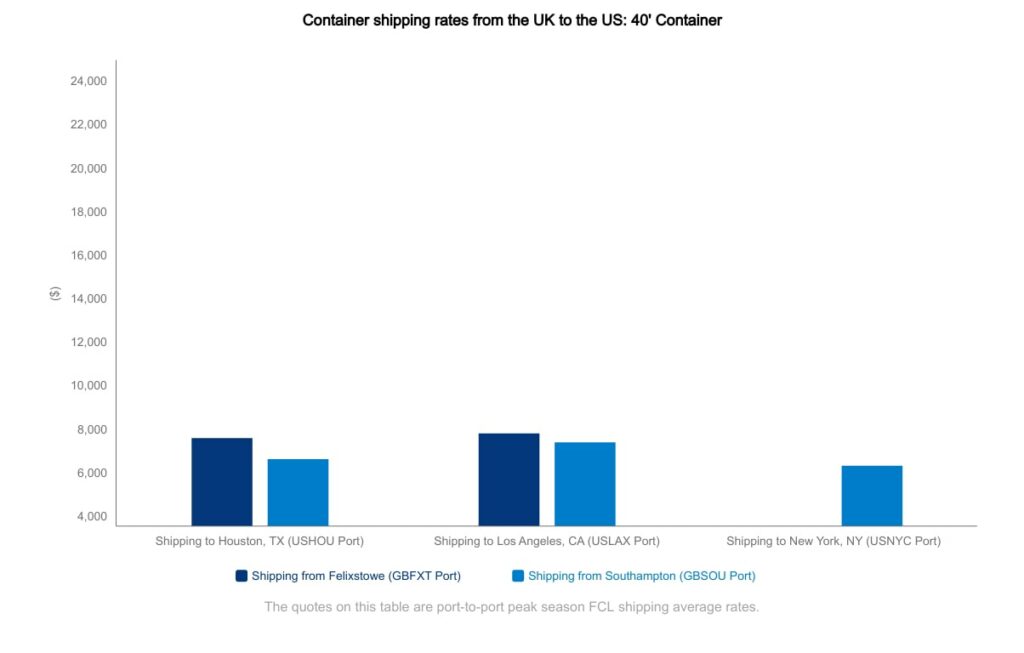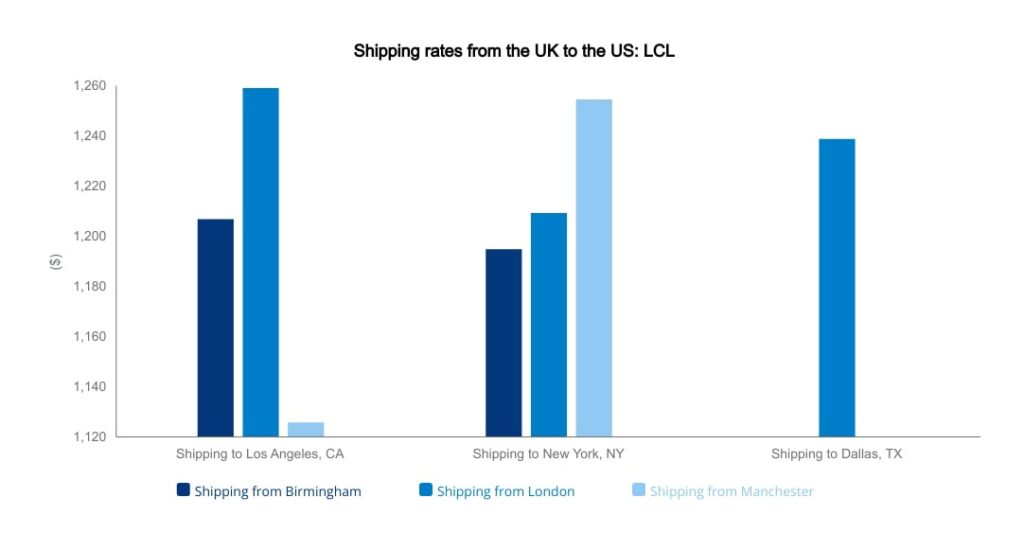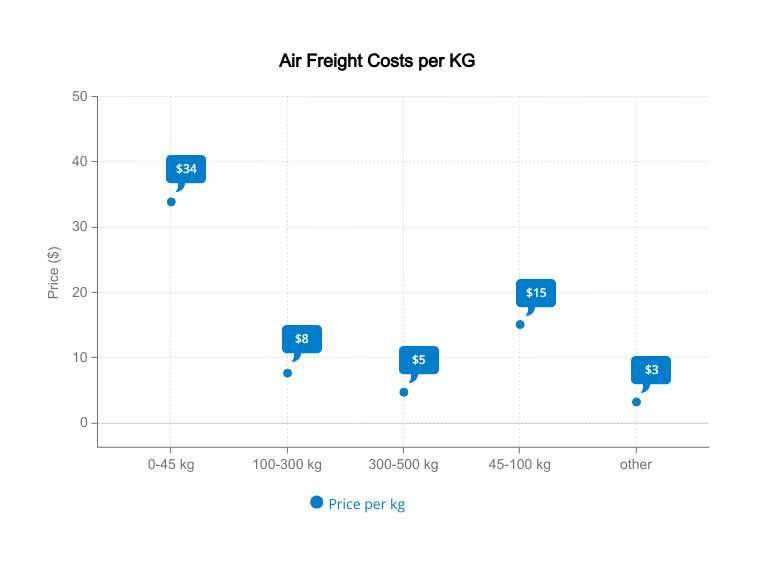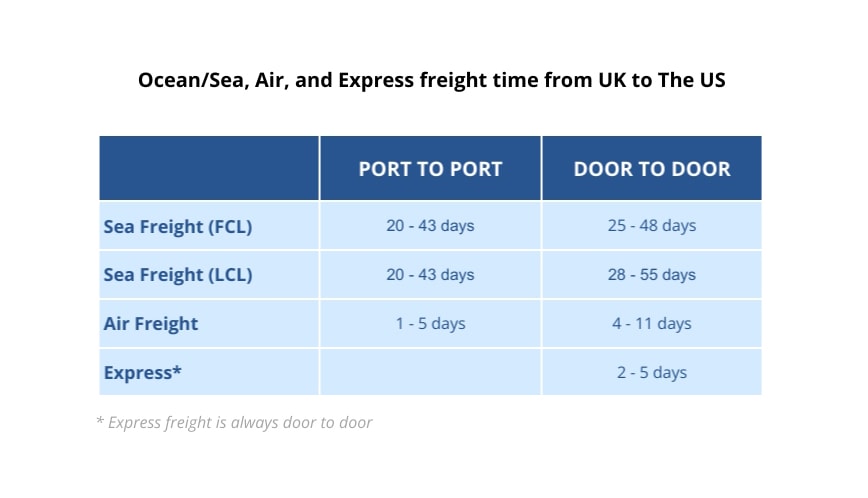Shipping Cost from the UK to the US
Freight rates determine how much it will cost to transport cargo from one point to another. The total cost is affected by the type of goods, the mode of transport, the dimensional weight of the cargo, and the distance to destination.
Other factors go into the cost of shipping, including location, size, and shipping mode: sea FCL, sea LCL, air, or express.
This guide will give you pricing estimates for each shipping mode from popular ports in the UK to popular ports in United States.
Ocean Freight from the UK to the US
Ocean Freight FCL
FCL, or full container load, means your goods fill an entire container, either 20’ or 40’ long. If you are shipping at a high volume, you’ll save time and money by shipping FCL. Pricing for FCL is done as a flat rate, regardless of whether or not your container is completely full.
Learn more about FCL here.

Ready to ship from the UK to the US?
Access live instant freight quotes
Ocean Freight LCL
LCL, or less than a container load, means your goods do not fill an entire container, and will be shipped along with other boxes or pallets. Note that when you ship LCL, your goods will need to be consolidated at the origin port and deconsolidated at the destination port.
That’s why LCL shipping takes a few days longer than FCL.

Air Freight from the UK to the US
Air cargo shipping cost from the UK to the US per kg
Shipping by air is generally faster but more expensive than shipping by ocean, so the mode you choose will depend on the size and weight of your shipment, and how quickly you need it to arrive at destination.
For help choosing which mode is right for your shipment, use our air vs. ocean comparison calculator.

Shipping from the UK to the US transit time
Ocean, Air and Express freight transit time from the UK to the US
How long will it take to ship from the UK to the US?
Your shipment’s transit time will be impacted by location, shipment size, and season. Transit times aren’t always the same. Depending on market conditions, acts of nature, and other occurrences, freight shipments may be delayed.
Use the following table for timing estimates for each shipping mode.

How much is shipping from the UK to the US?
International freight quote calculator & freight rate estimates for shipping goods by ocean, air, and truck
Get an estimate from the world’s largest database of freight rates with our freight calculator and then
join Freightos.com to compare, book, and manage your upcoming shipments.
Are you ready to book?
Just click the button to access live freight quotes from global logistics providers.
UK to US shipping delays: are shipments delayed?
For shippers from the UK to the US, the coronavirus has been profoundly disruptive, causing major delays to both manufacturing and shipping.
Production is back to normal, but COVID-19’s impact is creating a variety of other challenges including high demand for containers and delays at ports and warehouses.
Additionally, with new waves of the virus, restrictions on air travel can dramatically reduced air freight capacity, leaving space tight and prices volatile.
For the latest developments in international freight, visit the Freightos.com updates page.
It’s also important remember that freight rates are seasonal, with regular fluctuations throughout the year.
Freight rates, especially FCL sea freight and air freight rates, are affected by seasonal factors. When shipping from the UK to the United States, remember to take into account peak seasons in both the UK and the US.
Peak seasons for shipping from the UK to the United States
| Event | Effects on Shipping | When |
|---|---|---|
| Holiday Shopping Season | Prices rise as businesses prepare for holiday shopping | Fall months |
To see in-depth research on how pricing fluctuates throughout the year, check out the Freightos Baltic Index.
Cheapest shipping from from the UK to the US
When you’re shipping from the UK, you can choose from one of four modes: FCL sea freight, LCL sea freight, or air freight.
Here is a brief description of each mode:
FCL Sea Freight from the UK to the US
FCL, or full container load, means your goods fill an entire container, either 20’ or 40’ long. If you are shipping at a high volume, you’ll save time and money by shipping FCL. Pricing for FCL is done as a flat rate, regardless of whether or not your container is completely full. Learn more about FCL here.
LCL Sea Freight from the UK to the US
LCL, or less than a container load, means your goods do not fill an entire container, and will be shipped along with other boxes or pallets. Note that when you ship LCL, your goods will need to be consolidated at the origin port and deconsolidated at the destination port. That’s why LCL shipping takes a few days longer than FCL.
Air Freight from the UK to the US
Shipping by air is generally faster but more expensive than shipping by sea. For help choosing which mode is right for your shipment, use our air vs. ocean comparison calculator.
Shipping from the UK to the US pricing
Air freight costs and rates from the UK to the US
Standard air freight is the cheapest option for shipments between about 150 kilos and 500 kg. Very light shipments for their size might be charged on dimensional weight, rather than actual weight.
Air freight by far the fastest for the price. Express air freight is a little more expensive.
Freight rates can vary widely between freight forwarders and prices change regularly, so make sure you shop around.
For larger shipments sizes and origin/destination pairs, LCL (less than container load) ocean freight costs might actually be cheaper than air freight costs – make sure you check it out!
Sea freight costs and rates from the UK to the US
Once a shipment weighs more than around 500 kg, shipping by sea becomes the cheaper option. Ocean freight offers tremendous economies of scale (some ships can carry 20,000 twenty-foot containers) – but prices have risen steadily since summer 2020 making sea freight less economical than before the pandemic. Like air freight, ocean freight rates vary widely between forwarders and over time, so shop around before choosing your forwarder.
You can even start shopping around right now with our handy freight rate calculator. It will give you instant shipping estimates for both air and sea.
How can Air Freight be cheaper than Sea Freight?
Each shipping mode has its own combination of base and variable costs. Modes with a lower base cost are cheaper for smaller shipments while modes with lower variable weight costs are the cheaper options for larger shipments, even if they start out with a high base cost.
How long does it take to ship from the UK to the US?
Rules of thumbs for lead times (in regular conditions) are 1-2 weeks for regular post, 3 days for air express freight, 8-10 days for air freight, and 30-40 days for ocean freight.
These estimates can be affected by a wide range of circumstances, especially in the current market, so it’s worth checking with your logistics provider. With things the way they are, expect that there may be delays.
Beyond additional preparation, ocean liners also move slower to save fuel (and money) whenever possible.
On top of that, port congestion, customs delays, and bad weather condition affect sea freight more than they do for air freight.
More on Shipping Modes from the UK to the US
FCL Sea Freight from the UK to the United States
FCL, or full container load, means your goods fill an entire container, either 20’ or 40’ long. If you are shipping at a high volume, you’ll save time and money by shipping FCL. Pricing for FCL is done as a flat rate, regardless of whether or not your container is completely full. Learn more about FCL here.
LCL Sea Freight from the UK to the United States
Ocean freight usually means containers. But if you don’t have enough material to fill a full 20’ or 40’ container’s worth of shipment (FCL), it’s usually worthwhile to ship a less-than-container load (LCL).
With LCL, several shipments are consolidated and packed into one container. This means more work for the forwarder, and not just the physical work of consolidating various shipments into a container before the main transit, and de-consolidating the shipments at the other end.
It is more difficult to keep a trace of a shipment that is one of many in a container than it to keep tabs on a container with FCL. And of course, there’s extra paperwork involved, and more risk of delay.
For larger LCL shipments, it often makes more sense to upgrade to a 20-foot container and go FCL. The tipping point is typically somewhere around 15 cubic meters.
LCL, or less than a container load, means your goods do not fill an entire container, and will be shipped along with other boxes or pallets. Note that when you ship LCL, your goods will need to be consolidated at the origin port and deconsolidated at the destination port. That’s why LCL shipping takes a few days longer than FCL.
Air Freight from the UK to the United States
The larger the shipment, the more complex the shipping process. It’s harder finding space in a plane’s hold than with regular courier services and shipments are delivered to a facility where they are consolidated (packed with other shipments) first.
You also have to keep in mind that there are limitations on what products you can ship.
International law, national law, carrier organization regulations and individual carrier regulations all play their part in defining and restricting what goods are considered dangerous for transport.
Generally, more products are restricted as air cargo than ocean cargo, including: gases (e.g. lamp bulbs), all things flammable (e.g. perfume, Samsung Galaxy Note 7), toxic or corrosive items (e.g. batteries), magnetic substances (e.g. speakers), oxidizers and biochemical products (e.g. chemical medicines), and public health risks (e.g. untanned hides).
For further information on shipping hazardous material, check out the Freightos.com Hazardous Material Table.
Shipping by air is generally faster but more expensive than shipping by sea. For help choosing which mode is right for your shipment, use our air vs. ocean comparison calculator.
Express from the UK to the United States
When you have a small shipment and need it delivered as quickly as possible, you might consider express.
Freight Forwarders from the UK to the US
When shipping internationally, there’s a lot of factors involved in mastering your freight.
Getting the right mode is a good start.
If you are looking at air freight or ocean freight, make sure that when you request freight quotes that you are selecting a forwarder with a good reputation as well as a good price.
Find a Freight Forwarder
Using a freight forwarder will steer you clear of the pitfalls and take over the organizing and troubleshoot where necessary. But there’s one step that is often made before bringing in a forwarder. Before agreeing to a deal with your supplier, be sure that you understand about selecting incoterms.
Freight Documents and Forms
Having a forwarder means that you don’t need to understand everything about freight. But help yourself by being prepared for the barrage of paperwork and arm yourself with knowledge about freight documents.
You should take a few extra minutes to make sure that all documentation is complete and accurate. Those few minutes are very much worth the effort. And have a freight charges reference at hand; don’t blindly accept every surcharge and fee.
Use Correct Packaging
If you are looking at ongoing shipments, discuss packaging options with your supplier. You might be able to seriously cut freight costs.
FAQ
What are incoterms and how do they affect freight prices from the UK to the US?
When you’re comparing freight quotes, note the level of service the freight forwarder is offering.
For example, if you’re shipping from Felixstowe, UK to Los Angeles, United States, you’re going to want to ask your supplier about the cost difference between shipping from the supplier’s warehouse in Felixstowe– which means using the EXW incoterm– and shipping from the port of Felixstowe(GBFXT) – which means using the FOB incoterm.
Prices for FOB are typically lower, but shipping FOB doesn’t mean your total costs will necessarily be lower. You might make up the cost by paying your supplier to bring your goods to port. When comparing prices, take all your costs into account.
Note that some incoterms, including FOB, are used for sea shipping only.
Learn all about incoterms here.
What customs duties and taxes will I owe when shipping from the UK to the United States?
When importing from the UK to the US, you will need to pay Customs Duties before your goods are released into the country. These costs can be significant. Researching your costs early can keep you from getting caught by surprise.
How the Customs Process Works
When goods arrive at port, customs officials will first check to make sure all your paperwork is in order, and then calculate the amount of duties owed and collect payment. After payment, goods will be released.
To handle customs clearance, you can hire your own broker, or use the brokerage provided by your freight forwarder. If you book on Freightos.com, you can use our brokerage services as well.
Do I need insurance to ship from the UK to the United States?
When calculating your shipping costs, don’t forget to protect yourself in case your goods are damaged or lost. You can do this through your freight forwarder or a third party insurance agent. Insurance costs are typically around 0.3% – 0.5% of your Commercial Invoice Value, which is the amount you paid for the goods.
What paperwork do I need to ship from the UK to the United States?
When shipping freight from the UK to the United States, make sure to get all your paperwork, such as the Commercial Invoice and Bill of Lading, in order.
Use our paperwork checklist here to make sure all your paperwork is in order before you ship.
How do I ship from the UK to an Amazon FBA Warehouse in the United States?
As an Amazon shipper from the UK to the United States, you’ll need to consider issues of timing and storage, as well as choosing the right forwarder. Check out this guide to learn more.
Shipping ports in the UK
Your factory, supplier, or freight forwarder will likely advise you which port is best for your export from the UK , based on location, ease of customs clearance, transit time, port volume, and any relationships or agreements between the factory and the port.
If you’re choosing a port on your own, important factors to consider include location, cost, and transit time.
Here are the top ports for exporting from the UK:
Port Name: Felixstowe
Port code: GBFXT
Port Name: Southampton
Port code: GBSOU
Port Name: London
Port code: GBLON
Shipping ports in the United States
These are the top ports for importing into the United States:
Port Name: Los Angeles
Port code: USLAX
Port Name: New York
Port code: USNYC
Port Name: Houston
Port code: USHOU
Tips for Keeping Down Costs and Shipping Time from UK-US
- Book in advance. Shipping by sea is the cheapest, but also takes the longest. Booking in advance when you can saves you money– and cuts out the stress if delays arise.
- Ship off-peak. When carriers get busy, both shipping prices and transit times go up. Ship during off-peak seasons whenever you can.
- Get your documentation in order. Having your documentation in order can make all the difference when it comes to clearing customs quickly.
- Know your HS Codes. A lot of shippers are surprised by how much customs fees can affect business costs. Do your research so you can budget effectively.
- Compare quotes from different providers. Quotes can vary, so check out offers from different providers before making a decision.
- Understand what’s included in your quote. Is your quote port to port or door to door? What service does it include? Know what you’re paying for to avoid getting hit with surprise fees.